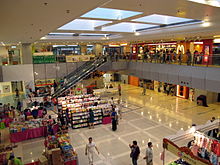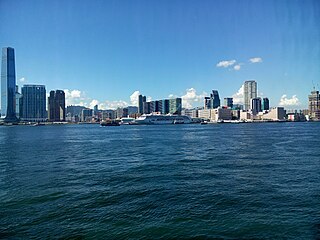
Kowloon is an urban area in Hong Kong comprising the Kowloon Peninsula and New Kowloon. It has a population of 2,019,533 and a population density of 43,033/km2 (111,450/sq mi) in 2006. It is one of the three regions of Hong Kong, along with Hong Kong Island and the New Territories, and is the smallest, second most populous and most densely populated.

Kwun Tong is an area in the Kwun Tong District of Hong Kong, situated at the eastern part of the Kowloon Peninsula, and its boundary stretches from Lion Rock in the north to Lei Yue Mun in the south, and from the winding paths of Kowloon Peak in the east to the north coast of the former Kai Tak Airport runway in the west.

Tseung Kwan O New Town, commonly known as Tseung Kwan O, is one of the nine new towns in Hong Kong, built mainly on reclaimed land in the northern half of Junk Bay in southeastern New Territories, after which it is named.

Lam Tin is a station on the Hong Kong MTR Kwun Tong line built as a part of the extension to Quarry Bay. The station is linked to the nearby hillside community of Lam Tin by a series of escalators.

Yau Tong is a station on the Hong Kong MTR Kwun Tong line and the Tseung Kwan O line. It is the only station of the Tseung Kwan O line located in Kowloon. The livery of the station is yellow. Although the train platforms are constructed above ground level, they are sealed from the outside with concrete walls to prevent the noise of trains from disturbing the nearby residents of Yau Tong Estate.

The Eastern Harbour Crossing, abbreviated as "EHC", is a combined road-rail tunnel that crosses beneath Victoria Harbour in Hong Kong. Opened on 21 September 1989, it connects Quarry Bay, Hong Kong Island and Cha Kwo Ling, Kowloon East.
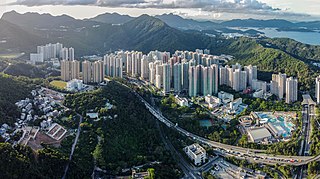
Po Lam is a neighbourhood in northern Tseung Kwan O, Kowloon. An MTR station with the same name, Tseung Kwan O Village, Yau Yue Wan Village, King Lam Estate, and Po Lam Estate are located there.

Kwun Tong is one of the 18 districts of Hong Kong. It is located in Kowloon, and is the easternmost and southernmost district in Kowloon. It had a population of 648,541 in 2016. The district has the second highest population in Hong Kong, after Sha Tin District, while the income is below average. Kwun Tong District borders Sai Kung District to the east, Wong Tai Sin District to the north, and Kowloon City District to the west. To the south is Victoria Harbour, and the Eastern District directly across on Hong Kong Island.

Lam Tin is an area in the Kwun Tong District in southeastern New Kowloon, Hong Kong. Lam Tin is primarily a residential area but also hosts a major transport interchange and several shopping attractions. Lam Tin was once a large field in the vicinity of Kowloon Bay. During the Song dynasty, it was a site of salt production. Since the 1980s, a number of housing estates were constructed in Lam Tin.

Lei Yue Mun is a short channel in Hong Kong. It lies between Junk Bay and Victoria Harbour, separating Kowloon and Hong Kong Island. The channel is an important passage for the city, forming the eastern entrance of Victoria Harbour.

Cha Kwo Ling is a hill in the eastern New Kowloon area of Hong Kong, and the area around it. It is adjacent to Victoria Harbour and located to the west of Yau Tong and southwest of Lam Tin. Administratively, it belongs to the Kwun Tong District. The northeastern entrance to the Eastern Harbour Crossing is located in this area.

Lei Yue Mun Road is a major road in Lam Tin, Hong Kong. It runs from the junction with Tsui Ping Road and Kwun Tong Road near MTR Kwun Tong station to the roundabout with Ko Chiu Road near Lei Yue Mun Estate in Yau Tong. The westernmost section of Lei Yue Mun Road is a part of Hong Kong Route 7 and serves as a connection between Route 7 and Route 2.

MegaBox is a large shopping centre in Hong Kong and part of the Enterprise Square Five shopping and office complex, located at 38 Wang Chiu Road, Kowloon Bay, Kowloon. With 19 stories and a floor area of 100,000 m2 (1,100,000 sq ft), MegaBox is the largest shopping centre in Eastern Kowloon.
The following is an overview of public housing estates in Yau Tong, Kwun Tong, Kowloon, Hong Kong, including Home Ownership Scheme (HOS), Private Sector Participation Scheme (PSPS), and Tenants Purchase Scheme (TPS) estates.
The following shows the public housing estates, including Home Ownership Scheme (HOS), Private Sector Participation Scheme (PSPS), Tenant Purchase Scheme (TPS) in Lam Tin of Kwun Tong District, Kowloon, Hong Kong.
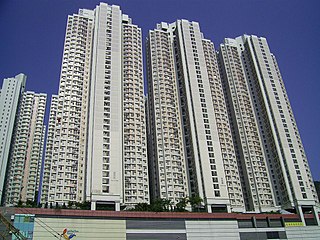
Yau Mei Court is a Home Ownership Scheme court and government quarters in Yau Tong, Kwun Tong District, Kowloon, Hong Kong, located along Lei Yue Mun Road next to MTR Yau Tong station.

Domain is a shopping centre located next to Yau Tong station in Yau Tong, Kwun Tong District, Kowloon, Hong Kong. The shopping centre is serving about 80,000 people in Yau Tong Estate, Yau Lai Estate, Yau Chui Court, Yau Mei Court and Lei Yue Mun Estate. It is the largest one owned by Hong Kong Housing Authority after most of its shopping centre assets were sold to Link REIT in 2005.
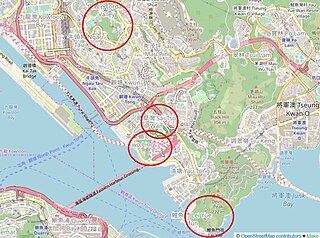
The Four Hills of Kowloon are four hills that were historically the site of granite quarries in Kwun Tong District, New Kowloon, Hong Kong.


